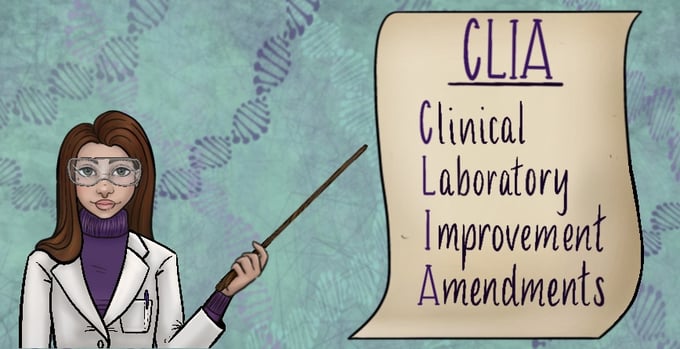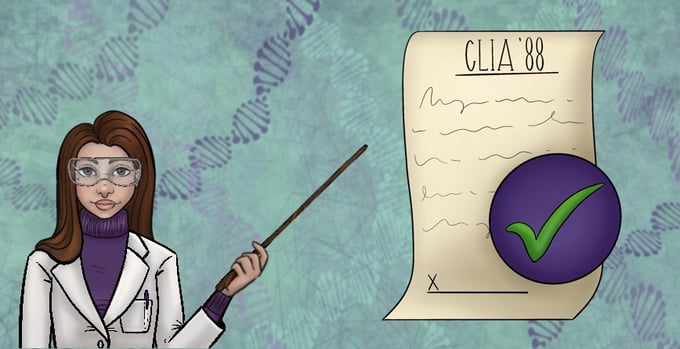Series Overview: Hi, my name is Shari and like the majority of our readers I don’t have a degree in science. What I do have is almost a decade of experience working closely with Genetic Counselors, and a passion for sharing genomic information in an approachable and easy to understand way. This passion was developed early in my career, fueled by my quickly building frustration about the over-complicated resources I found during initial attempts at self-guided learning. Genomics 101 is a blog series by GenomicMD that aims to be a solution to that frustration for others. By breaking down the complex language surrounding this field, we hope to empower people (like you!) to be more informed about how genomics can affect their healthcare journey.
Welcome back to Genomics101, our ongoing blog series dedicated to helping you grow your genomics knowledge without all the over-complicated scientific lingo. To recap, our first few posts in this series focused on building a foundational understanding of DNA in order to help our readers discuss genetic risks with their healthcare providers. Recently, we reviewed the terms “genetics” and “genomics” and explained how they apply to laboratory testing. Today, we will discuss the relationship between direct to consumer (DTC) and clinical laboratory testing, and how clinical labs (like GenomicMD) ensure the safety and quality of their laboratory test results.
Before we dive into this subject you might be wondering: “what does ‘direct to consumer’ actually mean?” Simply put, companies with a DTC business model sell their products and services directly to customers without a third-party retailer. Many technology-based businesses use this model, such as online retail shops or service providers. The bigger question is how DTC business models relate to genetic testing, and what that means for patients. To answer this question, we first need to set the stage by explaining a little bit about the laws surrounding clinical laboratory testing (opposed to research laboratory testing, which is not regulated by the Federal Government).

Thankfully, for the sake of both safety and ensuring quality laboratory test results, clinical laboratory medicine is regulated in the United States by a law known as the Clinical Laboratory Improvement Amendments of 1988 (CLIA ’88). A clinical laboratory test is defined by CLIA ‘88 as “examination of specimens obtained from humans for the purpose of providing information for health assessment and for the diagnosis, prevention, or treatment of disease.” Laboratory tests can fall into two categories: FDA cleared - or approved - tests and laboratory developed tests (LDTs) like the Lifetime Genomics Risk Assessment from GenomicMD. A clinical laboratory that wishes to make either of these types of tests available to clinicians for ordering must rigorously verify or validate their processes to not only comply with the (CLIA ’88) law but also ensure that their results are safe, effective, and consistent from day to day, specimen to specimen, and batch to batch.
CLIA ’88 not only covers the regulatory standards that dictate how lab tests are performed but also spells out the qualifications necessary for laboratory testing personnel, supervisors, doctoral-level laboratory directors, quality control, and proficiency testing - a process meant to ensure high laboratory performance. The CLIA process certifies a lab as “worthy of testing,” but most clinical laboratories, including genetic testing labs, like to go above and beyond CLIA ’88 and seek accreditation from additional organizations with deemed status under CLIA (for example, the College of American Pathologists - CAP). CLIA-certified and CAP-accredited clinical laboratories must live up to rigorous guidelines and are inspected as part of the accreditation renewal process every two years.

Laboratories that offer testing directly to consumers (with no request made by a treating physician or other healthcare provider) without CLIA certification are doing so illegally unless it is determined that the test result does not have a direct bearing on the diagnosis, prevention, or treatment of disease. For example, ancestry testing depends upon DNA analysis but many have termed this sort of testing “recreational genomics'' because the “test” result has no bearing on health; rather the results determines “% ethnicity or ancestry.” There are two important things to remember when distinguishing clinical laboratory testing from “recreational” testing (testing done for enjoyment or education rather than the diagnosis or treatment of a disease or condition) and where each type of testing is performed. First - testing that falls under CLIA must, by law, be done in a CLIA-certified clinical laboratory. Adherence to CLIA (and CAP) guidelines and rules helps to ensure the accuracy of testing results generated in such labs. Second - labs that do not do clinical testing but rather perform recreational testing may still generate results in a rigorous manner and reliable laboratory testing environment, but they are not bound by the legal requirements of CLIA ’88. This means that there is a significant dose of “buyer beware” to consider in choosing a DTC test or DTC lab.
Here's a bit more useful information on non-medical recreational tests, particularly in the genetics arena. Usually, such tests investigate things like familial relationships or ancestry. These types of tests examine the DNA of an individual to see how their unique genetic variations compare to patterns found in other people. Relationship testing checks for patterns that are likely to be shared between family members. Many people find value in how these test results are able to help uncover unknown family relationships and provide community via online forums. Some relationship testing (like forensic DNA testing or paternity testing) is bound by different laws than CLIA '88, such as the Federal DNA Identification Act of 1994. On the other hand, ancestry testing compares an individual’s genetic variations to those frequently shared among people of particular backgrounds. Such tests’ results can help explain how similar your DNA markers are to other people who have shared their data and also identify with a certain ethnicity or ancestry. For individuals, there is often comfort in finding community through a shared ancestral identity. For science, combined genetic ancestry test results from a large number of people can also be used to explore the history of populations as they rise, migrate, and mix with other groups. Remember, however, that the labs that generate such test results are not required to be covered by the law known as CLIA ’88 or bound by its standards because the nature of these tests is considered recreational.
When thinking about submitting a specimen (usually blood, saliva, or a cheek swab) for a genetic test, it’s important to understand the goal of the test result. The two main goals, either recreational or diagnostic testing (for management of a patient’s medical condition), are important things to consider in determining if a test is right for you. If your goal in testing is medically relevant, strongly consider whether or not the clinical laboratory your physician will use is CLIA-certified and - even better - CAP-accredited.

We hope you enjoyed this short genetics-focused lesson on the nature of recreational vs diagnostic testing. Eventually, our blog will delve more deeply into the many kinds of genetic tests that exist, such as genotyping, mutation sequencing, pharmacogenomics, non-invasive prenatal screening, and more. We hope these upcoming posts will help you develop a better understanding of what sort of tests may be best for you, so definitely stay tuned!
Blog Glossary:
Direct to Consumer (DTC) Testing - Companies with a direct to consumer businesses model sell their products and services directly to customers without a third-party retailer. In Genetics (and other laboratory medicine disciplines), DTC tests are ordered directly by the patient without a licensed healthcare provider involved serving as a legal intermediary.
Laboratory Developed Test (LDT) - A clinical grade test developed by a CLIA-certified (and likely CAP-accredited) clinical laboratory that has been rigorously validated prior to commercial availability.
CLIA (Clinical Laboratory Improvement Amendments of 1988) - A law that regulates all aspects of clinical laboratory testing in the US, including, but not limited to, the pre-analytical, analytical, and post-analytical components of testing. CLIA regulatory standards dictate how lab tests are offered, performed, the qualifications necessary for laboratory personnel, and required elements of quality control and proficiency testing. CLIA covers all aspects of clinical laboratory testing, not just genetics. For example, virology labs that test for the virus that causes COVID-19 or hematology labs that count white blood cells in a workup for leukemia must also be CLIA-certified.
CAP (College of American Pathologists) - a professional organization with deemed status under CLIA ’88 to inspect and accredit clinical laboratories
Ancestry Testing - compares an individual’s genetic variations to those that are frequently shared among people of particular backgrounds or ancestries. These tests’ results can inform whether your genetic markers are similar to collected information on people who live in or come from a specific region.
Relationship Testing - checks for patterns of genetic changes in an individual likely to be shared between family members
Recreational Testing - laboratory testing done for enjoyment and/or education rather than diagnosis or treatment of a disease or medical condition
Diagnostic Testing - laboratory testing done for diagnosis or management of a patient’s medical condition